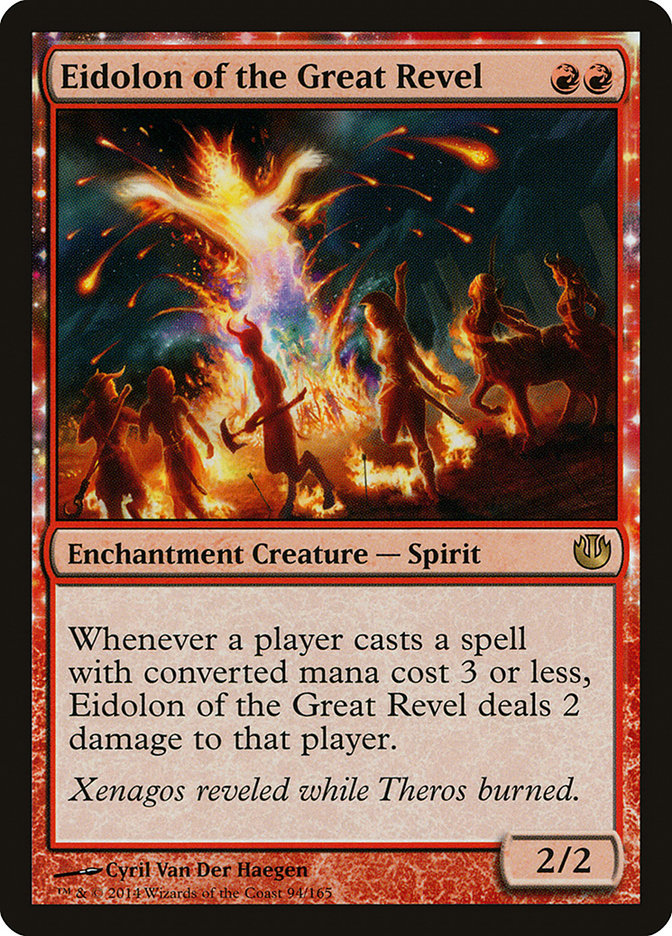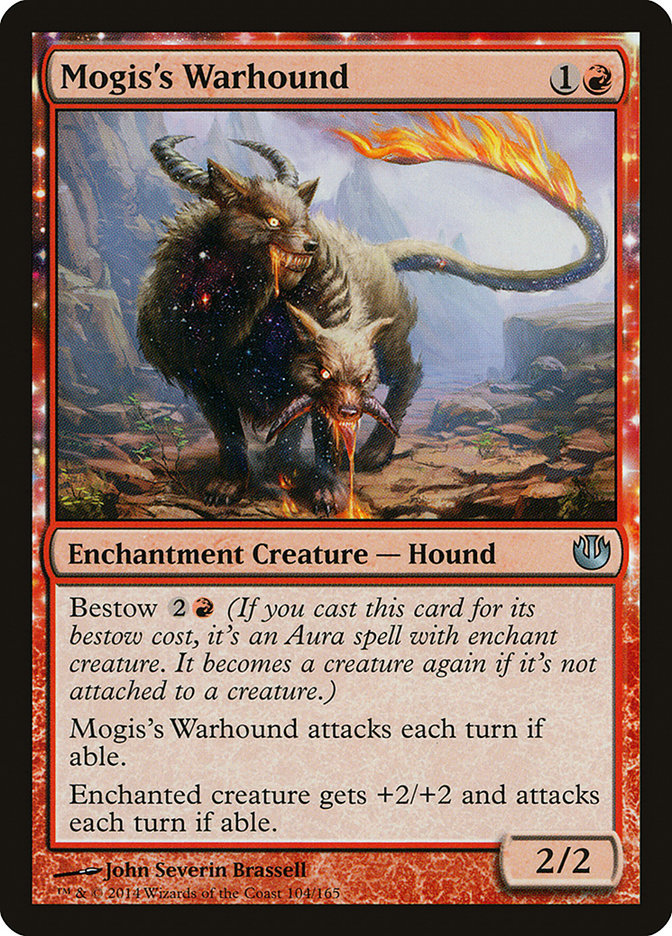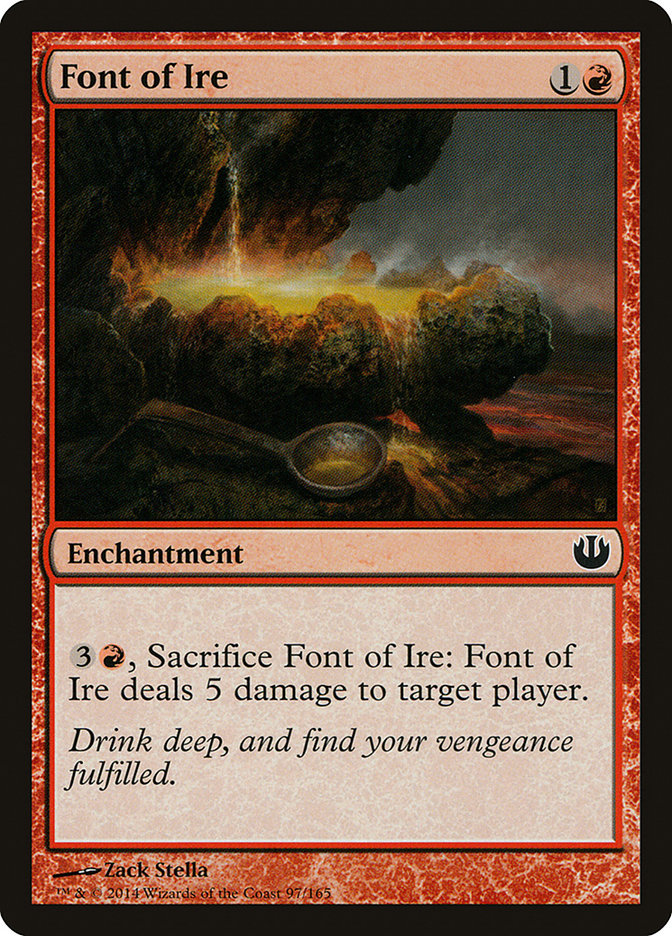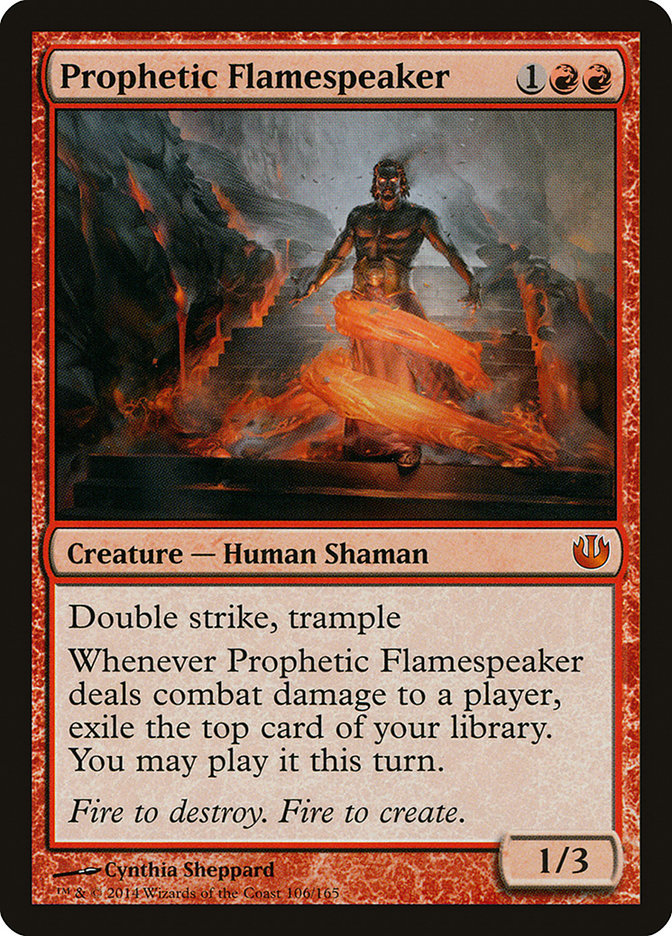Journey into Nyx is here and not a moment too soon. Though Born of the Gods ushered in some changes to Standard, like the rise of decks such as Jund Monsters and R/W Burn, many of those changes were illusory, and the finals of the SCG Standard Open in Detroit featured U/W Control and Mono-Black Devotion squaring off one more time. An injection of new content will cause people to brew new decks, propping up some diversity as people explore the new set, and if the content is sufficiently powerful, those changes could be lasting. This is the same hope the public had for Born of the Gods, but the set proved insufficiently powerful to meaningfully impact the metagame long term.
Of the decks on the fringes of the Standard metagame, red aggro has some of the best tools to punish Sphinx’s Revelation and Thoughtseize decks. Detention Sphere and Hero’s Downfall are great catchall answers, but they aren’t efficient answers to the Firedrinker Satyrs of the world. And the self-damage from Thoughtseize, Underworld Connections, and Ravnica dual lands is something an aggressive deck is poised to capitalize on.
There are a couple of different styles of red decks, from the "sock full of batteries" style that I advocate that’s full of cheap beaters and pump spells to aggressive devotion shell that Mike Flores suggests, but the foundation is the same—get on the board fast and render the common defensive tools inadequate to stem the tide. With a little bit of extra power, these decks could have the tools to be a top option, and several cards in Journey into Nyx have the potential to do just that. Beyond that one card in particular might influence some of Magic’s older formats, Legacy most notably.
This is the red card in Journey that has generated the most buzz and with good reason. Pyrostatic Pillar has a long history of being a potent sideboard card for red decks against some of the most troubling combo matchups, and a Pyrostatic Pillar that can attack is an entirely different animal. There has been a lot of speculation about what Eidolon will ultimately provide, and I think the answer varies quite a bit depending on format.
For Standard, don’t hold your breath. An aggressive red deck has to be flush with lots of cheap spells, and most Standard decks are capable of pressuring your life total even if they aren’t explicitly aggressive decks, like various devotion-based and Monsters decks. And any deck more saturated with cheap cards than you is probably an extremely aggressive strategy, meaning you can’t afford the life loss even if the Eidolon is triggering more against them than you. I could see this as a sideboard card against decks where your life total is close to meaningless (like Esper Control or Maze’s End), but I can’t fathom this card seeing much maindeck play.
Legacy is an entirely different animal. Nearly every deck revolves around a saturation of cheap spells, and Pyrostatic Pillar is already a card that appears in Burn sideboards. Eidolon is a serious upgrade in the matchups where you want a Pillar. Your opponent has less time to find an answer (since you’re hitting for two), and drawing the second copy is much more powerful (for the same reason). There is almost no question that it should be in the 75 somewhere. But should it be in the starting 60?
A lot of this is a metagame question, but for now I think the answer is no. The Delver matchups (especially RUG) are pretty close, but a Boltable Pillar would make the matchup much worse since these decks are fully capable of getting ahead of you on board (particularly with Tarmogoyf). Even though these decks are filled with cheap spells of their own, they can stop casting spells altogether once they get a presence on the board, and the same thing is not true of Burn. Other creature strategies, such as Merfolk, Elves, and Goblins, share this characteristic with Delver. For that reason I don’t think the card can see maindeck play right now given that various Delver strategies are the most likely decks you’ll encounter at a large Legacy event.
That said, this is an incredibly potent sideboard card. I generally stay away from Pyrostatic Pillar because it’s a bit slow and the diminishing returns are enormous, but one that can attack is a totally different equation. Not only is it much more powerful, but you can bring it in against a larger variety of opponents (you would never bring in Pillar against Sneak and Show unless you had totally dead cards to cut, but Eidolon is fine for example).
For the record, my Legacy Burn list with Journey into Nyx:
Creatures (8)
Lands (20)
Spells (32)

Part of the "drawback bestow" cycle at uncommon, Mogis’s Warhound is potentially suited for the type of red deck I’ve been playing in Standard the last few months. Gore-House Chainwalker is something of a necessary evil to ensure enough Burning-Tree Emissary plays, which the Warhound can also fulfill (though it’s much worse to cast than a Chainwalker). The upside is that you get a three-mana Giant Strength with a minor drawback when you want it. So where are the spots that this is valuable?
- It can be used to push through a troublesome defensive creature like Courser of Kruphix. Since I advocate playing Firefist Striker and Rubblebelt Maaka, more pump spells with low opportunity cost are attractive.
- It’s a good way to develop your board in the face of sweepers. If you get hit with Supreme Verdict, you get to keep the Warhound and gets to attack the following turn, and it can push your creatures out of Drown in Sorrow or Anger of the Gods range.
- It acts as a haste creature with its full attack value in the face of Jace, Architect of Thought’s plus power, which is a big deal.
- Getting a creature into 4/4 or larger territory is potent against Boros Reckoner, as the Reckoner only trades instead of eating multiple cards (and again, you keep the Warhound).
These are significant advantages. The costs of course are that this is pathetic as a two-drop (even by my standards) and enchantment removal is most likely going to be all over the place (at least at the start of the season). My red deck has no maindeck targets for Revoke Existence or Deicide, so adding the first ones is a big cost.
I suspect I’m going to start by cutting two Chainwalkers for two Warhounds and seeing how it goes. The upside is significant, and there’s a general argument for diversification of threats in the face of Bile Blight and Detention Sphere. Where the spread ultimately lands is going to depend on metagame specifics, but this card is worthy of consideration for the red decks I’ve been playing recently.
Many red decks sideboard Skullcrack for decks like Esper Control in part for lack of anything better. It is an answer to life gain, but the most common form of life gain is Sphinx’s Revelation. It is fine in those spots, but you will often lose to the cards they’re drawing unless your board is advanced or the three damage just kills them. Still, you’re in the market for some amount of direct damage to hedge a bit against Supreme Verdict and to ensure you aren’t just locked out by Elspeth, Sun’s Champion. Skullcrack fulfills those obligations, but it isn’t that much better than Lightning Strike even though the Esper deck has its share of life gain.
Font of Ire has the potential to be much better than Skullcrack for that job. It can be cast on the second turn underneath permission and then loom for the remainder of the game. Your opponent can’t even set up a Revelation plus a counterspell (the most common way for them to beat Skullcrack) because Ire just sits in play. It can also kill a Jace or Elspeth straight away if that’s something you’re interested in.
Ire comes with some limitations. It’s very expensive to hold up, so there’s only so many copies you can realistically sideboard. It gets tagged by Detention Sphere and Pithing Needle, though the former is taxed on everything you cast and Needle often has to just name Mutavault. And it is an enchantment, meaning it gets hit by cards like Revoke Existence that have very few targets otherwise. It is also not a full replacement for Skullcrack, as that card has value fighting things like Warleader’s Helix and Blood Baron of Vizkopa.
Still, this is a high-impact card that will be reminiscent of Shrine of Burning Rage in certain spots. There is a ceiling on the number of these you can play, but it can do excellent work diversifying your angles of attack against Verdict and Elspeth while contorting your opponent’s ability to resolve Revelation.
My updated tentative red decklist for the first week of Standard with Journey into Nyx:
Creatures (32)
- 4 Chandra's Phoenix
- 2 Gore-House Chainwalker
- 4 Rakdos Cackler
- 4 Burning-Tree Emissary
- 4 Firefist Striker
- 4 Foundry Street Denizen
- 4 Rubblebelt Maaka
- 4 Firedrinker Satyr
- 2 Mogis's Warhound
Lands (22)
Spells (6)
Sideboard

This is the splashiest red design in Journey into Nyx, with tons of "wow!" factor. If Prophetic Flamespeaker goes unopposed, it can essentially draw two cards a turn with a little bit of luck, and trample plus double strike is a great combination in concert with pump spells.
With that said, I think this card will struggle to find a home in Standard, at least for the time being. Three-mana creatures that don’t have the potential to immediately impact the board or have resistance to commonly played removal have no home in Standard given the pressures that Detention Sphere, Hero’s Downfall, and Supreme Verdict place on creatures. Sylvan Caryatid is another commonly played card that causes Prophetic Flamespeaker all sorts of fits.
However, this could be an incredible sideboard card in burn strategies if your opponent is caught unaware. You can clear out blockers with all of your removal, and you should have no trouble assembling a lethal amount of damage with all the extra cards you’ll see. Most opponents will keep in some number of Detention Sphere or Last Breath type of cards out of respect for Chandra’s Phoenix and Ash Zealot, but if the metagame ever moves to a place where people expect burn decks to be creatureless post-board, look out for Prophetic Flamespeaker.
Satyr Hoplite is nothing flashy but is a potentially critical role player. Red heroic was a fringe Standard player at times (most notably in the hands of Tom Ross), but besides Akroan Crusader the deck lacked much of a heroic payoff. Satyr Hoplite gives the deck an additional one-drop, one that’s especially well suited to get loaded up with Dragon’s Mantle and Madcap Skills. I’m not a huge fan of decks this extreme as a rule, but Satyr Hoplite may give the deck a sufficient base of "quality" heroic targets to make it legitimate. A test list (mostly inspired by Ross’ list from earlier in the Standard season):
Creatures (26)
- 4 Ash Zealot
- 4 Rakdos Cackler
- 3 Legion Loyalist
- 4 Foundry Street Denizen
- 4 Akroan Crusader
- 3 Arena Athlete
- 4 Satyr Hoplite
Lands (17)
- 17 Mountain
Spells (17)
Sideboard

Journey into Nyx has a deep pool of cards for those of you who like to beat down and burn out. Eidolon of the Great Revel is the most impactful card released for Legacy Burn since Searing Blaze, and the set is flush with potent role players for aggressive red decks in Standard. With red already well positioned to fight the monsters of Thoughtseize and Sphinx’s Revelation, just a little push may be all that is required for red to become one of the top Standard decks. I’m very excited to see how Standard shakes out at the SCG Open Series in Cincinnati next weekend and beyond.





